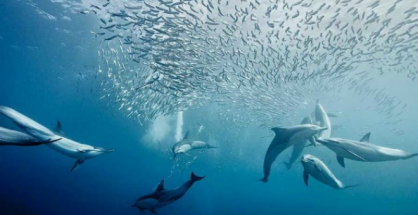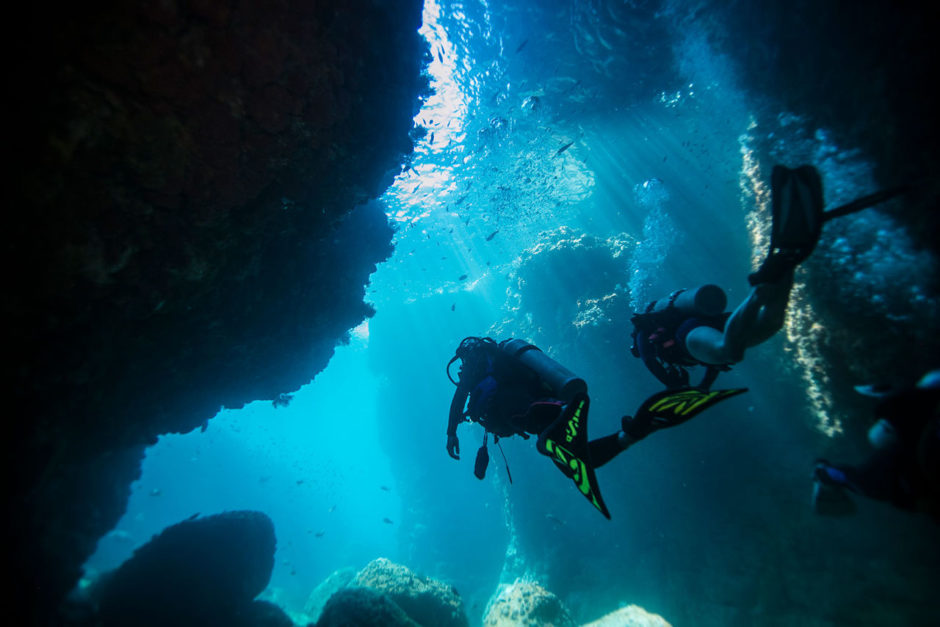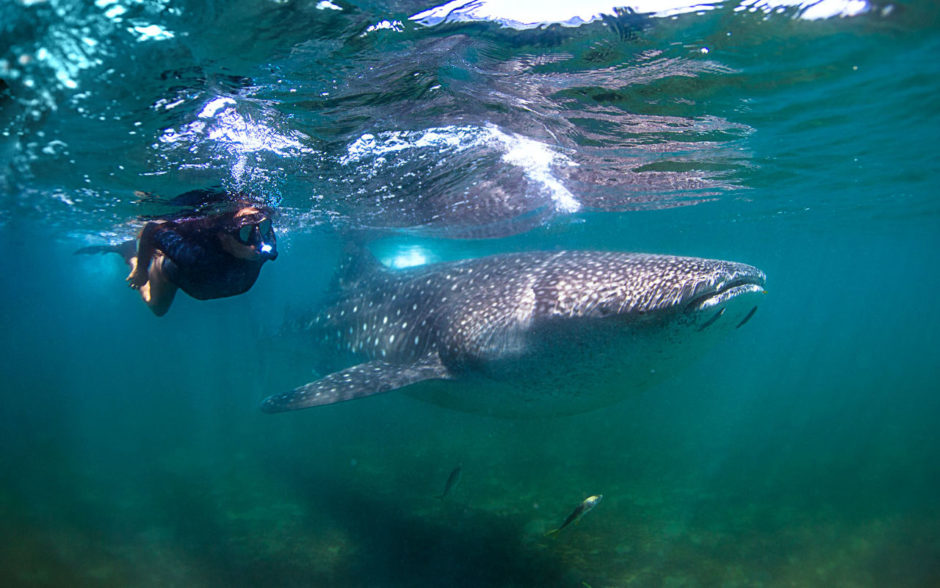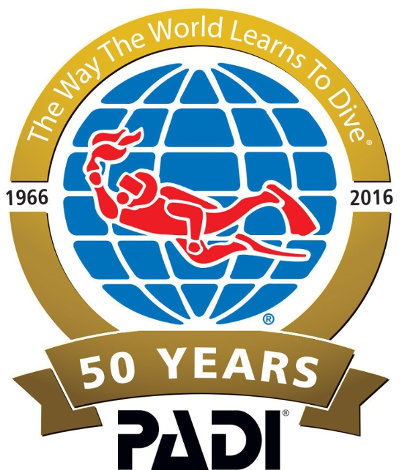THERE’S A MEXICO you haven’t seen yet. A Mexico that starts beyond the 5,800 miles of shoreline, below the surface of the warm, clear ocean waters. The Mexico of Jacques Cousteau — but much easier to access than it was in his time. Grab a wetsuit, mask, regulator, and a couple of fins, carry the weight of a tank, and take one giant step forward into a world of bubbles, turtles, and coral unlike anything you’ve seen.
It’s down here that colorful fish live in sunken rusty ships on the seabed. Stingrays, snappers, and grunts hide in reefs. Maritime plants dance to the rhythm of the currents over human-made statues. Your breath is the only background music, your heartbeat the only rhythm. Challenge your vertigo in total darkness or stare into the abyss and dive vertically beside it. A whole new perspective on Mexico awaits. Here are 10 of the country’s best spots, roughly organized from easiest to most difficult.
1. Punta Nizuc
Photo: Malcolm Browne
Punta Nizuc is a protected offshore reef on the southernmost tip of the Hotel Zone strip in Cancun. With a maximum depth of roughly 30 feet, it’s great for beginners. Here you can start exploring underwater, snap your first underwater photos, and meet your first lobsters, groupers, stingrays, and sergeant majors. While you’re diving over fields of sea fans — think big, soft corals — you’ll find the “The Gardener of Hope,” a statue of a young girl lying in a coral garden. It’s one of the over 500 statues of the MUSA, an underwater museum and also an artistic initiative to protect Cancun’s coral reefs. It’s located just off these shores, Cancun’s, and Isla Mujeres’ (see below).
But back to Punta Nizuc: You won’t find much of a current here, and the waters are so shallow that you probably don’t need a diving certification. It’s a great place to get used to a mask and snorkel and being in the water for extended periods of time. Sign up for a beginner’s course, and you’ll learn your first underwater skills: how to equalize, clean your mask, use a regulator, etc.
Find a PADI Dive Center near Punta Nizuc (search Cancun)
2. Isla Mujeres
Photo: 2il org
On the surface, Isla Mujeres is a four-mile-long island that’s just a short boat ride away from the resorts of Cancun (it’s the island north of Punta Nizuc). On this stretch of Caribbean terrain, there’s about 50 different diving spots — budget at least a few days so you don’t leave feeling like you’ve only skimmed the surface.
A good place to start is the southwest part of the island in the 30-to-40-foot-deep waters of the Manchones Reef. Here you can swim through a field of elk horn, stag horn, and brain coral. The light penetrates the water and routinely shines on different schools of blue, yellow, and striped fish, making this a hot spot for underwater photography. Keep swimming east, head toward the MUSA, and play hide and seek with the fish feeding off the subaquatic plants on the statues — and on the life-sized sculpture of a VW Beetle.
Around the island, you also have the reefs of Tavos, Media Luna, and Sleeping Sharks Cave. If you’re experienced enough, go deeper and head through the rusty entrances of the C55 Barrera or C58 Anaya, old US Navy minesweepers sitting on the flat, sandy bottom of the Caribbean. Those with an advanced certification can visit the 100-foot-deep Ultrafreeze shipwreck. You can also submerge at dusk, switch on your torch, and let the beam introduce you to fish you’d never see otherwise, then switch it off and see beyond the darkness.
Most dive spots around Isla Mujeres are between 30 and 70 feet deep. Open Water — the basic certification for depths up to 60 feet — is easy enough to obtain. Find a scuba center that offers PADI certification and you can get started. The course involves some book work, a dive in a pool (or “confined water”) to start off, and then you’ll dive four times in the “open water” — usually an ocean — and show your diving instructor you can do everything she or he taught you. That’s it! You’re certified.
Find a PADI Dive Center near Isla Mujeres (search Isla Mujeres)
3. Pelican Rock
Photo: jrsnchzhrs
The incredible rocky formations off Cabo San Lucas might distract you from what goes on in underwater Baja. Rookie mistake — there’s more if you’re willing to dive for it. Pelican Rock is near the bay just before Land’s End and really can’t be missed — the giant, craggy behemoths sticking out of the sea tend to give it away. You might not see swarms of pelicans here, but there are snappers, sea bass, angelfish, frogfish, and lobsters hiding in the fissures. Start at 20 feet and watch schools of fish zigzagging in front of you as you descend to 60 feet towards the vast subaquatic canyon that drops down to 3,000 feet. You can’t see the bottom, but you might be lucky enough to spy playful sea lions, whitetip sharks, or a manta ray. It’s not exactly difficult, but it’s diverse enough that even advanced divers are attracted to the seascape here.
For Pelican Rock — and for all the spots on this list — your dive center will have all the gear you need, most likely speak multiple languages, and employ instructors who’ve dived thousands of times in these waters and know the currents well. Most will host multiple trips in the morning, some in the afternoon, and — if you’re qualified — you might be able to arrange a night dive, too.
Find a PADI Dive Center near Pelican Rock (search Cabo San Lucas)
4. Palancar Garden
Photo: Stokes rx
If bumping into a stingray or saying hello to a barracuda sounds good to you, check this one out. Palancar Garden is one of the four sections of Palancar Reef, a vast and diverse coral reef located on the southwest of Cozumel, part of the Arrecifes de Cozumel National Park. Start on the shallow, sandy bottom of the Caribbean and head away from the island — you’ll notice formations of purple and orange sponges mixed with coral multiplying until there are thousands of colorful coral species and yellow tube sponges around you. Fish love it here for good reason, as do photographers.
If you’re comfortable and experienced, go deeper through the swim-throughs and channels sided by high rocky formations sheltering you from the outside currents. Look through the fissures, feel the water cooling down slightly, and watch the black coral appear in the deeper areas until your surroundings become less defined and you can sense it’s time to head back.
The light blue, crystal clear waters of the Caribbean, the national park, and the colors within the water make this a very popular site. With depths from 30 feet to 80 feet, any diver will end up enraptured. Dive shops in both Playa del Carmen and Cozumel can set you up for a trip to Palancar, and there are enough options in these parts that you can go with the flow and let the current take you (basically) anywhere.
Find a PADI Dive Center near Palancar Garden (search Cozumel)
5. Columbia Wall
Photo: Mandy
Just south of Palancar, off the southwestern tip of Cozumel, is where you’ll find the Columbia reef (the Columbia Wall is a part of this system). You’ll start where the smooth bottom is around 30 feet deep and head west towards Playa del Carmen and the bottomless depths that separate these two landmasses. Go through the subaquatic fields of the Columbia Shallows, swim over the flat, sandy floor, and watch the terrain turn into a colorful, uneven spectrum of different textures inhabited by large barracudas, sea turtles, eagle rays, and nurse sharks. Swim next to high rocky walls (hence the site’s name), and follow the inviting tunnels and swim-throughs decorated with coral formations.
This is an ideal spot for any certified diver, in part because it’s fairly remote and rarely crowded. The current is usually moderate, and the depth ranges from 50 to 90 feet. There are a lot of big fish in the area, and the visibility is incredibly high. The terrain is uneven and exciting — so exciting it’s easy to go too far and end up at Columbia Deep, staring into the abyss. Be careful! Keep your eyes on your depth gauge, and hire an experienced local divemaster to guide you.
Find a PADI Dive Center near Columbia Wall (search Cozumel)
6. Cenotes
Photo: Pavel Yudaev
In Mexico’s Yucatan, you don’t even need the ocean to have a spectacular dive experience. Head inland from the Caribbean and you’ll find about 3,000 different sinkholes, or cenotes, most of which are diveable. From the surface, some look like small lakes or ponds; others are much harder to spot as the land covers them with shrubs, grasses, or fallen trees. In general, their surface size is deceiving. Even a small, inconspicuous “hole in the ground” can turn into something remarkable — once you’re inside.
When you begin descending into a cenote, it will quickly open up — and then open up some more. Take note: The draw of the cenotes is not their aquatic life…although it’s easy to spot freshwater turtles in the Carwash Cenote. The true appeal of these dive sites is found in their elaborate limestone formations and the beams of sunlight unfurling like curtains in the water, creating a cathedral-like effect all around you. Each cenote has its particular charm — some are crystal clear, others are dark, and others have sulfur clouds. Every dive, even in the same cenote, is unique.
Cenotes can be up to 300 feet deep; you need to be a certified diver to take them on. Since these cavernous lakes abound on the Yucatan Peninsula, you’ll probably be looking for a dive center in Playa del Carmen, Tulum, or anywhere in between. What’s more important than where you go is that you make sure your guide is a certified cave diver, holds an official cenote guide certification, and has all the right gear. The safer you feel, the more you’ll enjoy exploring the Mayan underworld.
Find a PADI Dive Center near the cenotes (search Playa del Carmen or Tulum)
7. Green Wall
Photo: Malcolm Browne
This dive spot, not far from Playa del Carmen, is very similar to other sites west of Cozumel, although the water here is darker and there’s generally less visibility. The smaller isolated walls of the larger, all-encompassing Green Wall, or Pared Verde, are together a sort of underwater island in the middle of a sandy plain. As you go over the reef carpet and get closer to the wall, you’ll see schools of grunts, eels, queen angelfish, ocean triggerfish, lobsters, hawksbill turtles, and stingrays hiding in the sand as you head to the deeper areas.
With depths up to 100 feet, this is a great location to do an advanced certification course. On your way back, look for the natural chimney — go through the hole at the bottom and swim up to the top to start your ascent back to the surface. Take note here: The current is real and can’t be ignored.
Find a PADI Dive Center near Green Wall (search Playa del Carmen)
8. Devil’s Throat
Photo courtesy of PADI
To check Devil’s Throat off your list, head to the southernmost point of Cozumel and start your dive at roughly 100 feet. Swim through a passageway of coral, and then feel the space narrowing — you’ll be going through a tunnel lined with red sponges. Use the beam of your torch to guide the way, and look ahead to spot the butterfly and angelfish. In the swim-throughs, be sure not to kick the sandy bottom — sediment will rise, making it difficult to see (the last thing you want when making your way through a tight spot). If you avoid the sand, windows of clear blue turn Devil’s Throat into a twisted, enchanted, cavernous experience.
It’s not a technically difficult dive, but you should have a few dozen dives under your belt before attempting it. Complete your advanced qualification and go with a divemaster who knows the area well. Remember to do a safety stop for three minutes before ascending to avoid decompression sickness. Follow your instructor’s guidance to get to the surface and then, most likely, do it again.
Find a PADI Dive Center near Devil’s Throat (search Cozumel)
9. Marisla Seamount
Photo courtesy of PADI
Also known as El Bajo, these three underwater peaks are about eight miles northeast of La Paz in Baja California, not very far from Isle Lotes. Hop on a boat out of La Paz for 90 minutes, descend into the shallow waters off the central peak, and then head north to descend to around 100 feet.
This spot is known for the schools of hammerhead sharks that hang out in the area — you might see anywhere from six to as many as a hundred. Don’t worry: You’re interested in them, but they aren’t interested in you. If for some reason they fail to show up, there are plenty of other creatures to keep you busy — like amberjacks, tuna, octopus, turtles, and a local colony of panamic green moray living in a small nearby canyon. Other frequent visitors to the seamount include whale sharks and giant Pacific manta rays.
This is the world’s signature schooling hammerhead dive — one of just three places of the world where this happens. As if that weren’t enough, in the middle of the ocean everything changes — visibility, currents, what fish decide to show up. All this combined means this is one truly awesome dive for the advanced diver.
Find a PADI Dive Center near Marisla Seamount (search La Paz)
10. Socorro Islands
Photo: Elias Lavy
These islands, located 250 miles off the southern tip of Baja, are also known as the Revillagigedo Archipelago. They’re four completely isolated and uninhabited volcanic islands with several good diving spots, though the dive conditions — from visibility to water temperatures — can change dramatically as you pass through different underwater ecosystems.
Dive sites around these islands are a far cry from the bright colors of the coral reefs near the Mexican mainland; here, it’s size that matters. In San Benedicto, you’ll spot giant Pacific manta rays with wingspans of up to 24 feet. Around Isla Socorro, you might see dolphins and humpback whales from January through March or April. On Roca Partida, large schools of jacks and tuna often swim next to a seamount wall going straight down to the abyss. And Clarion Island is home to the Clarion Angelfish.
The bad news is that these “Mexican Galapagos” are the country’s most challenging dive spot to access. You’ll spend more than a week living on a boat to make the trip…although who said living on a boat was a bad thing? The difficulty of the dive will vary according to the island, the currents, and the waves. Take your logbook — you’ll need it — and an underwater camera so you can load up your Insta account when you’re back online. Some spots require that you’re at an advanced level and have done at least 50 logged dives. The good news? This will be the dive of your life.
Find a PADI Dive Center for a trip to the Socorro Islands (search Cabo San Lucas) ![]()













